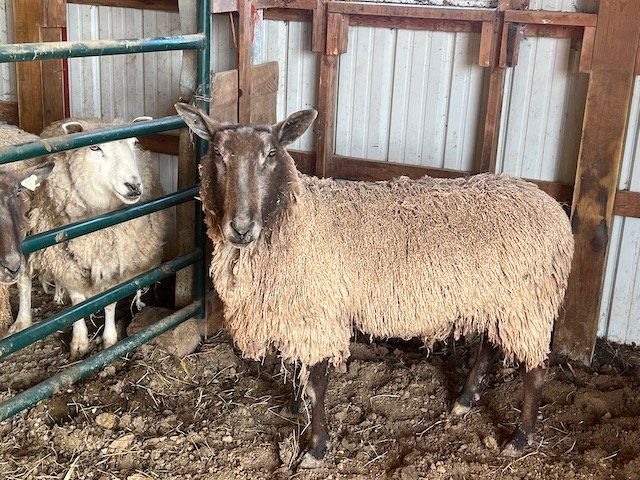
We sheared our flock of 11 sheep this past Saturday. And when I say “we”, that’s a bit of a simplification. Shearing is a team effort! It couldn’t be done without our incredible shearer Danny Smith. Danny is a third-generation shearer and always does a fabulous job. Friends were there to help too, plus my sheep wrangling hubby.
I get lots of questions about our sheep and shearing. First, our sheep are predominately Blue Faced Leicester. We have several pure BFL, two crosses of BFL/Corriedale, a Polypay/BFL and a Shetland cross wether. This small flock keeps me busy and gives us enough locally sourced yarn to offer in my webshop. We don’t keep a ram, just ewes and wethers. No more lambing for us!
How often do you shear?
BFL need to be sheared once a year, this year we were about a month over, so the fleeces are extra long. If we wait too long, the fleece will start to felt on the sheep, and too long of a lock can be a problem for the mill. None of that is a problem this year, every fleece looked fabulous. I can’t wait to get them sent to the mill to be processed into yarn.
Do you spin the yarn?
No, I can hand spin yarn, but not this quantity, so fleeces are skirted a second time, washed and then sent to a small mill to be processed into yarn.
Does shearing hurt them?
No. They love it! They are very relaxed during shearing and bounce around like lambs after. They do occasionally get a small nick that heals within a day. They actually have to get to know each other after shearing as they don’t seem to recognize each other!
How much does a fleece weigh?
A BFL fleece is fairly light. Rough skirted they weigh 4-5 pounds each. Once washed, probably 3-3.5 pounds, carding loss brings it down to 2-2.5pounds, so it takes almost one full fleece of BFL wool yarn to knit a sweater! Our BFL/Corriedale cross fleeces are much heavier, weighing closer to 10 pounds after a rough skirting. If we shear in less than a year, the final weight of sheep wool per animal is much less.
Do you sell the fleeces?
Yes, message me if you are interested in any. The BFL/Corriedale fleeces are amazing to hand process and spin, so those are sometime sold.
What is next?
Next, I will spread the fleeces out on a skirting table again and pick through them carefully, looking for large pieces of vegetable matter, burrs, and dirty wool. Then I will soak in cold water to remove large amount of dirt, then two hot washes and several hot rinses, being careful not to felt the fleeces. Fleeces are spun out and spread on my screen porch to dry, then sent to the mill. It’s quite a process best suited for several days of warm dry weather.
That leaves the next question! What is your favorite ply and weight of yarn to work with? Pure BFL, or maybe a wool and silk yarn? The mill can do single, 2, 3 and 4 ply. However, cost goes up with number of plies. The mill can spin laceweight to bulky. I love Blue Faced Leicester sock yarn but prefer using my English Garden Perennial yarn for socks. It is definitely not less expensive to raise your own sheep for yarn!
Natural or Dyed?
I have natural BFL yarn for sale in my shop, but I am an Indie Dyer after all, and love to overdye my BFL wool yarn. The heathered colors of Parsley, Lily and Anise give incredible depth to hand dyed yarn. Message me for details if you’d like to have yarn custom dyed from my natural Blue Faced Leicester yarn.
Enjoy the pics. And yes, the sheep are all named, and all my Annual BFL yarns are named after one of the sheep that contributed to the yarn!



